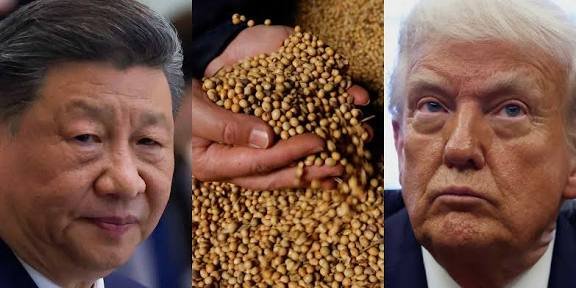Headache for Trump: US Soybean Farmers Face Worst Crisis in Decades as China Halts Imports.
America’s soybean farmers, once the reliable powerhouse of U.S. agricultural exports, are facing their biggest crisis in decades. The trade war with China has pushed relations to breaking point, and Beijing has now halted all imports of U.S. soybeans—a move that has devastated rural economies and created a major political headache for former President Donald Trump.
For decades, China was the largest buyer of American soybeans, accounting for nearly 60% of exports. With Beijing turning to Brazil, Argentina, and other suppliers, U.S. farmers are left with collapsing prices, record stockpiles, and a grim financial outlook.
Why Soybeans Matter
Soybeans are more than just a crop; they are a pillar of U.S. agriculture, generating nearly $40 billion annually in exports. They are used in animal feed, vegetable oil, and even biofuels, making them essential to both global food chains and energy markets.
The Midwest—particularly Iowa, Illinois, Indiana, and Missouri—forms the backbone of U.S. soybean production. Farmers here depend heavily on exports, and China’s halt has pulled the rug out from under them.
How the Trade War Sparked the Crisis
The crisis began with Trump’s decision to impose tariffs on Chinese imports in a bid to pressure Beijing into a new trade deal. China retaliated with tariffs of its own, specifically targeting agriculture—the sector most closely tied to Trump’s voter base.
Soybeans became the prime casualty. First, China cut back purchases. Then, as negotiations collapsed, Beijing completely stopped buying U.S. soybeans, redirecting demand to Brazil and other markets.
“China knew exactly where to strike,” says Dr. Emily Harrington, an international trade analyst at Georgetown University. “By hitting soybeans, they hit Trump’s strongest political base in the Midwest.”
Farmers Struggle as Prices Collapse
The fallout on the ground has been severe:
Soybean prices have dropped to their lowest levels in more than a decade, averaging under $9 a bushel on the Chicago Board of Trade.
Farm debt has climbed above $500 billion, according to USDA estimates, with many farmers struggling to repay loans taken for the planting season.
Farm bankruptcies are up more than 20% compared to last year, as smaller family farms buckle under financial pressure.
Storage silos across the Midwest are overflowing with unsold crops. Many farmers are being forced to sell at steep losses or rely on government aid just to keep their operations afloat.
“We’re drowning in soybeans nobody wants,” says Mark Peterson, a farmer from Iowa. “We don’t need bailouts—we need markets.”
Political Backlash in Rural America
This crisis has political consequences. Soybean-growing states were central to Trump’s victories, but with farm incomes collapsing, rural support is fraying.
Democrats have seized on the issue, portraying Trump’s tariff strategy as a failed gamble that hurt American farmers more than it pressured Beijing. Even among lifelong Republican voters, frustration is mounting.
“We backed Trump because he promised to fight for us,” says Jennifer Morales, a farmer from Illinois. “But instead, his policies are fighting against us.”
Global Soybean Trade Realigns
Perhaps the most worrying aspect is the permanent shift in global soybean trade. China has found reliable alternatives in Brazil and Argentina, both of which have expanded production to meet demand.
Brazil, already the world’s largest exporter, has seen exports to China surge by more than 30%. Analysts warn that even if U.S.-China relations improve, Beijing may never return to relying on U.S. soybeans as heavily as before.
“This is not just a temporary disruption,” says Harrington. “It’s a structural change in the global market.”
Bailouts: A Band-Aid, Not a Cure
To cushion the blow, Washington has rolled out billions in farm aid packages. But critics argue that subsidies are no substitute for stable markets.
Farmers agree. While the checks help cover short-term losses, they don’t address the long-term problem of lost export demand.
“You can’t replace a market with a government handout,” says Tom Larson, a farmer in Indiana. “This is survival money, not prosperity.”
Long-Term Consequences for U.S. Agriculture
Economists warn of ripple effects that could reshape U.S. farming for years:
1. Reduced acreage – Many farmers are expected to cut soybean planting and shift to corn, wheat, or other crops.
2. Farm consolidation – Small and mid-sized family farms may not survive, leading to further concentration of farmland under large agribusiness.
3. Rural decline – Struggling farms mean weaker local economies, declining populations, and shuttered small-town businesses.
4. Lost leverage – America’s diminished role in global soybean exports weakens its bargaining power in future trade negotiations.
Can Farmers Recover?
Recovery will not be easy. Diversifying exports to Europe, Southeast Asia, or Africa could offer partial relief, but none of those regions match China’s massive demand.
Domestically, some see opportunities in biofuels, plant-based proteins, and new industrial uses for soybeans. But these markets will take time to grow, and farmers fear they cannot wait that long.
“We need a long-term agricultural strategy,” Harrington argues. “Tariffs and subsidies are not a solution. Without new markets, U.S. farmers risk losing their global competitiveness.”
Conclusion: A Crisis With No Easy Answers
The U.S. soybean crisis is more than a trade dispute—it’s a test of resilience for America’s farmers and a warning about the costs of weaponizing trade. What began as a political strategy has now spiraled into a full-blown rural crisis, leaving thousands of farm families uncertain about their future.
For Trump, the fallout is not just economic but political. The very communities that once rallied behind him are now asking whether his trade war was worth the price. For America’s farmers, the answer seems painfully clear: without China, the soybean belt faces its darkest chapter in decades.
Yuvamorcha.com, Creditmoneyfinance.com, Startupindia.club, Economiclawpractice.com

